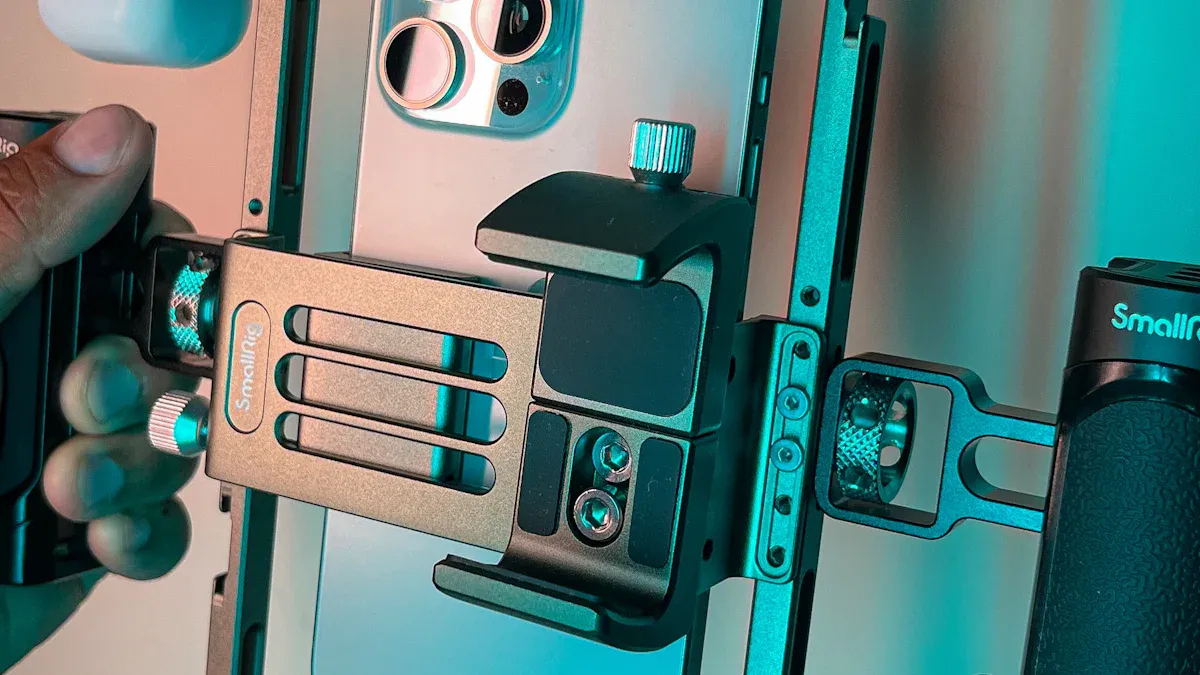The Ultimate Guide to AI Voice Receptionist Prompts in 2025

AI voice receptionists have transformed how businesses interact with customers. Over the past decade, these systems have evolved from basic automated tools to advanced solutions capable of human-like conversations. With advancements in natural language processing and machine learning, they now handle tasks like appointment scheduling and answering inquiries with remarkable accuracy. Businesses benefit from 24/7 support, reduced operational costs, and improved customer satisfaction.
Companies like Appointify AI lead this revolution by offering innovative solutions that enhance communication. The key to their success lies in crafting the best AI voice receptionist prompt. Clear and relevant prompts ensure efficient interactions, making these systems indispensable for modern businesses.
Key Takeaways
AI voice receptionists help customers anytime. They cut wait times and make people happier.
Good prompts are key for clear communication. Simple prompts help AI understand what customers need fast.
Personalizing AI responses builds trust. Custom replies based on past chats make customers feel special.
Testing and improving prompts often keeps them working well. This helps AI adjust to new business needs and customer wants.
Watching things like solved calls and happy customers shows what to fix. This improves service quality.
Understanding AI Voice Receptionists
What Is an AI Voice Receptionist?
An AI voice receptionist is an advanced virtual assistant designed to handle customer interactions. It uses artificial intelligence to communicate in a natural, human-like manner. You can rely on it to manage tasks such as answering calls, scheduling appointments, and providing information. Unlike traditional systems, it operates continuously, ensuring no customer inquiry goes unanswered. This technology combines natural language processing and machine learning to deliver seamless and efficient communication.
Key Features and Benefits
AI voice receptionists come with a range of features that make them indispensable for businesses. Here are some of the key functionalities:
They interact with customers in a conversational tone, creating a positive experience.
They handle appointment scheduling and share information effortlessly.
They manage calls, respond to emails, and send texts without missing a beat.
They automate routine tasks, freeing up your staff for more complex responsibilities.
The benefits of using an AI voice receptionist are equally impressive:
It ensures customers receive assistance 24/7, eliminating wait times.
It improves efficiency by managing multiple calls simultaneously.
It reduces operational costs, offering a cost-effective alternative to human receptionists.
It enhances customer satisfaction with quick and accurate responses.
How AI Voice Receptionists Transform Businesses
AI voice receptionists revolutionize how businesses operate. By automating repetitive tasks, they allow your team to focus on strategic goals. Their ability to integrate with existing systems ensures consistency in customer interactions. With 24/7 availability, they enhance customer satisfaction and loyalty. Additionally, they streamline operations by handling multiple calls at once, ensuring no customer waits. This efficiency not only saves time but also reduces costs, making them a valuable asset for any business.
The Importance of AI Voice Receptionist Prompts
Enhancing Communication Efficiency
AI voice receptionists rely on well-crafted prompts to streamline communication. A clear and concise prompt ensures the system understands your customer’s needs quickly. For example, customizing FAQ prompts can reduce routine calls by 40%, allowing your team to focus on more complex tasks. Businesses like pest control services have seen 35% of calls resolved without human involvement by prioritizing emergencies. Offering precise time slots through scheduling prompts can also boost booking completion rates by 68%, shortening call times to under 90 seconds.
Effective prompts improve understanding and response accuracy. They allow the AI to interpret requests correctly, delivering relevant information aligned with your business goals. By facilitating natural conversations, prompts make interactions feel more human and engaging. This adaptability ensures the AI handles various scenarios confidently, enhancing communication efficiency across the board.
Improving Customer Experience
A well-designed AI voice receptionist prompt can transform customer interactions into positive experiences. By integrating with CRM systems, the AI remembers past interactions, offering personalized attention. This tailored approach makes every interaction feel relevant and meaningful. For instance, businesses using effective prompts have reported a 22% increase in customer satisfaction scores.
Prompts that encourage feedback also contribute to enhanced customer service. A custom welcome prompt like, “We value your opinion! After this call, you’ll have the option to take a short survey,” invites customers to share their thoughts. This not only improves service quality but also strengthens customer relationships. By addressing individual needs and preferences, the AI creates a seamless and satisfying experience.
Reducing Errors in Interactions
Optimized prompts play a crucial role in minimizing errors during customer interactions. Clear instructions and context help the AI avoid misunderstandings, ensuring accurate responses. Tailored prompts have been shown to reduce call errors by 40%, leading to smoother communication and higher customer satisfaction.
For example, a warm welcome prompt sets the tone for the conversation, making customers feel valued. This approach reduces confusion and builds trust. By eliminating common mistakes, the AI voice receptionist delivers consistent and reliable service. This not only enhances customer loyalty but also boosts your business’s reputation for professionalism.
Crafting the Best AI Voice Receptionist Prompt
Principles of Effective Prompts
Crafting an effective AI voice receptionist prompt requires a thoughtful approach. By following key principles, you can ensure your AI delivers accurate and engaging responses.
Clarity and Simplicity
Use clear and simple language to avoid confusion. Avoid technical jargon or overly complex phrasing. For example, instead of saying, "Please elucidate the available time slots," you can say, "What times are available?" This ensures the AI understands your instructions and responds appropriately.Providing Context and Relevance
Always provide background information to help the AI understand the situation. For instance, if a customer asks about a product, include details like the product name or category in the prompt. This context allows the AI to deliver precise and relevant answers.Maintaining a Professional Tone
Set a tone that aligns with your brand's voice. Whether your business is formal or casual, ensure the AI reflects that style. A professional tone builds trust and enhances the customer experience.Iterative Testing and Refinement
Experiment with different prompts and refine them based on the AI's responses. Testing helps identify areas for improvement, ensuring the AI voice receptionist performs optimally. Regular updates keep the system aligned with your business needs.
Tip: Define the desired output for each prompt. Specify whether you want a brief answer, detailed explanation, or specific action. This clarity guides the AI and improves response accuracy.
Common Mistakes to Avoid
When creating prompts for your AI voice receptionist, avoid these common pitfalls:
Using vague or unclear language that confuses the AI.
Failing to provide enough context for the AI to understand the situation.
Overlooking the importance of tone, leading to responses that feel out of place.
Neglecting to test and refine prompts, which can result in inconsistent performance.
Ignoring customer feedback, which is crucial for improving the AI's interactions.
By addressing these mistakes, you can create the best AI voice receptionist prompt that enhances communication and customer satisfaction.
Examples of the Best AI Voice Receptionist Prompts for 2025

Greeting Prompts
Welcoming Customers
A warm welcome prompt sets the tone for a positive interaction. Using time-based greetings adds a personal touch and improves first-call resolution rates by 65%. For example:
"Good morning, welcome to [Company Name]. How can I assist you today?"
"Good evening, thank you for calling [Company Name]. What can I help you with?"
Tailoring greetings to your industry can also enhance customer satisfaction. A hotel might say, "Welcome to [Hotel Name]. We’re delighted to have you. How may I assist you?" Meanwhile, a hair salon could use, "Thank you for calling [Salon Name]. Are you looking to book an appointment or learn about our services?"
Introducing Business Services
Introducing your services clearly helps customers understand their options. For instance:
"For prescription refills, press 1. For new patients, press 2."
This approach reduces call transfers by 40%. After-hours prompts like, "Schedule online at [URL] or leave a detailed message," improve accessibility and boost your online presence.
Scheduling Prompts
Initial Ask Prompts
Start scheduling conversations naturally. A simple question like, "Let’s get you scheduled. What day works best for you?" opens the dialogue and makes the process feel effortless.
Time Selection Prompts
Offering clear choices simplifies decision-making. For example:
"I have openings at 2 PM and 4 PM. Which time suits you better?"
This prompt ensures clarity and keeps the conversation efficient.
Confirmation Prompts
Confirming details builds trust and reduces errors. Use a prompt like, "I’ve got you down for [date] at [time]. You’ll receive a text reminder 24 hours before." This reassures the customer and reinforces professionalism.
Inquiry Handling Prompts
Answering FAQs
AI voice receptionists excel at answering common questions. A basic prompt like, "Thank you for calling [Your Company Name]. How can I help you today?" ensures customers feel heard. For business hours, you might say, "Our regular hours are Monday to Friday, 9 AM to 5 PM. We also offer emergency services 24/7."
Redirecting to Human Support
When the AI cannot resolve an issue, redirecting to a human receptionist is essential. A prompt like, "Let me connect you to a team member who can assist further," ensures seamless transitions and maintains customer satisfaction.
Tip: Always test and refine your prompts to ensure they align with your business goals and customer needs.
Information Collection Prompts
Gathering Contact Details
AI voice receptionists excel at collecting customer contact details efficiently. A well-designed prompt ensures you gather accurate information while maintaining a smooth interaction. For example, you can use a prompt like, "Can I have your name and phone number to assist you better?" This direct approach encourages customers to provide the necessary details without hesitation.
You should also consider prompts that confirm the information provided. A follow-up like, "Let me confirm your phone number: [repeat number]. Is that correct?" reduces errors and builds trust. These prompts not only streamline the process but also enhance the customer experience by showing attention to detail.
When crafting prompts for contact collection, focus on clarity and simplicity. Avoid asking for too much information at once. Instead, break the process into smaller steps. This approach keeps the interaction natural and prevents customers from feeling overwhelmed.
Collecting Feedback
Gathering feedback is essential for improving your services and understanding customer needs. AI voice receptionists can make this process seamless with the right prompts. A great example is, "We value your opinion! After this call, you will have the option to take a short survey. Your feedback helps us improve our service. Press 1 to begin the survey, or press 2 to end the call." This prompt invites customers to share their thoughts in a non-intrusive way.
Research shows that businesses using AI-driven feedback systems resolve issues 25% faster and retain 19% more customers. By encouraging feedback, you not only improve your services but also strengthen customer relationships. Prompts that offer multiple channels for feedback, such as surveys or follow-up calls, can further enhance participation rates.
To create the best ai voice receptionist prompt for feedback collection, ensure it aligns with your brand's tone and values. Keep the language polite and appreciative. A simple "Thank you for your time and input" at the end of the interaction leaves a positive impression and encourages future engagement.
Implementing AI Voice Receptionists in Your Business
Defining Business Needs
Before implementing an AI voice receptionist, you need to define your business needs clearly. Start by identifying the tasks you want the AI to handle. Do you need it to manage appointment scheduling, answer FAQs, or provide real-time call routing? Next, consider the pain points in your current customer interactions. Are long wait times or missed calls affecting your service quality? Finally, establish how you will measure success. Metrics like reduced call handling time or increased customer satisfaction can help you evaluate the AI's performance.
To ensure the AI aligns with your goals, focus on its key features. For example:
Key Features | Description |
|---|---|
Intelligent Call Routing | Directs calls to the appropriate department or person. |
Voicemail Management | Handles and organizes voicemail messages efficiently. |
Unlimited Parallel Call Handling | Manages multiple calls simultaneously to improve service. |
By addressing these factors, you can create a roadmap for implementing an intelligent voice assistant that meets your business requirements.
Choosing the Right AI Platform (e.g., Appointify AI)
Selecting the right AI platform is crucial for success. Evaluate platforms like Appointify AI based on the following criteria:
Pricing Models: Compare costs to find a solution that fits your budget.
Features: Look for functionalities like callback option prompts and enhanced customer service capabilities.
Usability: Ensure the platform is user-friendly for your team.
Integration Capabilities: Check how well it integrates with your existing systems.
Scalability: Choose a platform that can grow with your business.
Appointify AI, for instance, offers robust features and seamless integration, making it an excellent choice for automating customer service. By carefully assessing these factors, you can select a platform that aligns with your operational needs and long-term goals.
Crafting and Testing Prompts
Crafting the best AI voice receptionist prompt requires a strategic approach. Focus on clarity and relevance to ensure the AI understands and responds accurately. For example, a prompt like, "How may I assist you today?" sets the stage for a smooth interaction. Testing these prompts is equally important. Conduct iterative testing to refine the AI's responses and improve its performance over time.
When testing, simulate real-world scenarios to identify potential issues. Adjust the prompts based on customer feedback to enhance their effectiveness. Regular updates ensure the AI-powered receptionist stays aligned with your evolving business needs. By investing time in crafting and testing prompts, you can create a system that delivers consistent and reliable service.
Monitoring and Optimizing Performance
To get the most out of your AI voice receptionist, you need to monitor its performance regularly and make improvements. This ensures the system continues to meet your business goals and delivers a great customer experience.
Key Metrics to Track
Start by identifying the metrics that matter most to your business. These could include:
Call Resolution Rate: The percentage of calls resolved without human intervention.
Customer Satisfaction (CSAT): Feedback from customers about their experience.
Average Call Duration: The time it takes to complete a call.
Error Rate: The frequency of incorrect responses or misunderstandings.
Tracking these metrics helps you understand how well the AI is performing and where it needs improvement.
Tools and Techniques for Monitoring
Use analytics tools provided by your AI platform to gather performance data. Platforms like Appointify AI often include dashboards that display real-time metrics. You can also review call transcripts to identify patterns or recurring issues.
Tip: Schedule regular performance reviews. Monthly or quarterly evaluations help you stay proactive and address problems before they escalate.
Optimizing for Better Results
Once you identify areas for improvement, take action. Update prompts to make them clearer or more relevant. Train the AI with new data to handle emerging customer needs. Test changes in a controlled environment before rolling them out.
Encourage customer feedback to guide your optimization efforts. A simple post-call survey can reveal valuable insights. By continuously refining your AI voice receptionist, you ensure it remains a reliable and effective tool for your business.
Future Trends in AI Voice Receptionist Technology

Personalization and Customization
AI voice receptionists are becoming more personalized than ever. With advancements in natural language processing (NLP), these systems can now understand not just words but also the emotions behind them. This allows the AI to engage in nuanced conversations, making interactions feel more human. For example, the AI can detect frustration in a customer’s tone and adjust its responses to be more empathetic.
Personalization goes beyond emotions. AI receptionists can tailor responses based on customer data and past interactions. Imagine being greeted by name or receiving service suggestions based on your previous inquiries. These small touches foster loyalty and make customers feel valued. Additionally, emotional AI is evolving to detect and respond to user emotions, creating a more engaging and satisfying experience.
Integration with Advanced AI Models
The integration of advanced AI models is transforming how voice receptionists operate. Machine learning models trained on diverse datasets now excel at recognizing accents, improving communication in customer service. Enhanced speech recognition capabilities ensure that the AI understands your requests accurately, even in noisy environments.
These systems also automate routine tasks like appointment scheduling and answering FAQs. By handling these responsibilities, the AI allows your human staff to focus on more complex issues. Integration with tools like CRM and scheduling software ensures a seamless experience for both customers and employees. Furthermore, AI receptionists can manage multiple calls simultaneously, boosting efficiency and customer satisfaction.
Multilingual and Cross-Cultural Capabilities
AI voice receptionists are breaking language barriers with multilingual and cross-cultural capabilities. Technologies like NLP and machine learning enable these systems to adapt to new languages and dialects. For example, voice recognition technology transcribes speech into text with high accuracy, ensuring precise understanding of spoken language.
Technology | Description |
|---|---|
Enhances language accuracy and contextual understanding, improving customer interactions. | |
Machine Learning | Allows AI receptionists to adapt and learn new languages and dialects from previous interactions. |
Voice Recognition Technology | Transcribes speech to text with high accuracy, enabling precise understanding of spoken language. |
Cultural Training Modules | Provides deeper understanding of cultural references and regional variations in communication. |
Cultural training modules further enhance these systems by teaching them regional variations and cultural nuances. This ensures that your AI voice receptionist communicates effectively, no matter where your customers are located.
Enhanced Emotional Intelligence in AI
AI voice receptionists are becoming more emotionally intelligent, allowing them to connect with customers on a deeper level. These systems now analyze vocal tones, speech patterns, and word choices to detect emotions like frustration, happiness, or confusion. By recognizing these emotional cues, the AI can adjust its responses to match the caller's mood, creating a more empathetic and human-like interaction.
Several innovations drive this enhanced emotional intelligence:
AI systems use emotion analysis to gauge a caller's emotional state, improving trust and satisfaction.
Advanced algorithms enable the AI to understand context and respond naturally during conversations.
Machine learning trains the AI to recognize emotions based on voice tone, pauses, and word selection.
For example, if a customer sounds frustrated, the AI might respond with a calm and reassuring tone, saying, "I understand this is important to you. Let me help resolve this quickly." This ability to adapt builds trust and makes customers feel valued.
Emotionally intelligent AI also improves problem-solving. By identifying when a caller feels confused or upset, the system can prioritize clarity and offer additional support. For instance, it might provide step-by-step instructions or connect the caller to a human representative when necessary. These thoughtful adjustments reduce misunderstandings and enhance the overall experience.
As you implement AI voice receptionists, consider how emotional intelligence can benefit your business. It not only improves customer satisfaction but also strengthens loyalty by making every interaction feel personal and meaningful. With these advancements, AI is no longer just a tool—it becomes a trusted partner in delivering exceptional service.
AI voice receptionists have become essential for businesses aiming to enhance customer interactions and streamline operations. With well-crafted prompts, these systems achieve over 75% call resolution rates, reduce handle time by up to 50 seconds, and improve customer satisfaction scores by 25%.
With AI voice receptionists, businesses can ensure that every customer interaction is handled promptly and efficiently, leading to a more positive customer experience overall.
Adopting solutions like Appointify AI positions your business for growth. The global AI voice market, projected to reach $5.4 billion in 2024, offers immense opportunities. By embracing this technology, you can reduce costs, improve efficiency, and stay ahead in a competitive landscape.
FAQ
What is the role of prompts in AI voice receptionists?
Prompts guide the AI to respond accurately and efficiently. They help the system understand customer needs and provide relevant answers. Well-crafted prompts improve communication, reduce errors, and enhance the overall customer experience.
How do I create effective prompts for my AI voice receptionist?
Focus on clarity and simplicity. Use direct language and avoid jargon. Provide context to help the AI understand the situation. Test and refine your prompts regularly to ensure they align with your business goals.
Tip: Always define the desired outcome for each prompt to improve accuracy.
Can AI voice receptionists handle multiple languages?
Yes, many AI voice receptionists support multilingual capabilities. They use advanced natural language processing to understand and respond in different languages. This feature helps businesses serve diverse customer bases effectively.
How do I measure the performance of my AI voice receptionist?
Track metrics like call resolution rate, customer satisfaction scores, and average call duration. Use analytics tools provided by your AI platform to monitor performance. Regular reviews help identify areas for improvement.
What industries benefit most from AI voice receptionists?
Industries like healthcare, hospitality, retail, and customer service benefit greatly. These systems handle tasks like appointment scheduling, answering FAQs, and managing inquiries. They improve efficiency and enhance customer satisfaction across various sectors.
Note: Even small businesses can leverage AI voice receptionists to streamline operations and reduce costs.
See Also
Automating Phone Calls Using AI Voice Agents by 2025
Create Your Own AI Virtual Receptionist in Just 5 Minutes
Exploring Voice Call Features of AI for Employees
Transforming Appointment Scheduling with AI Voice Chat Technology

